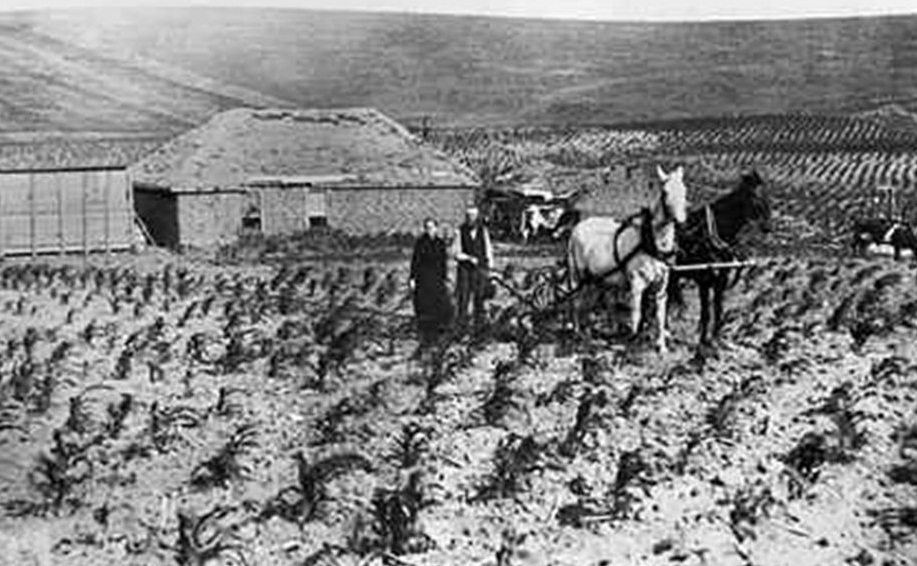
While the most common stereotype of Plains Indians brings forth an image of horse-mounted buffalo-hunting nomads living in tipis, many of the Plains Indian nations were farmers who lived in permanent villages and raised crops of corn (maize), beans, and squash. The Mandans were among the earliest farming nations on the Northern Plains. Their villages were along the Missouri River in the Dakotas. Mandan migrations, farming, hunting, and fishing are described below.
Archaeologists feel that the Mandan first moved to the banks of the Missouri River in what is now South Dakota from northwestern Iowa or southwestern Minnesota. After five centuries in this area, there was a climatic change (the Pacific I climate episode) which drove them north into present-day North Dakota. The photographer and ethnographer Edward Curtis reports: “Mandan tradition tells of a gradual migration up the Missouri ‘from the place where the river flows into the great water’.” Curtis, in reviewing Mandan oral tradition, concludes: “One can hardly doubt, therefore, that the Mandan dwelt originally in the warm Gulf region near the mouth of the Mississippi.”
For two centuries their villages lay north of the Grand River. In their 1917 book Corn Among the Indians of the Upper Missouri, George Will and George Hyde write: “The Mandans were evidently the first Siouan tribe to reach the Upper Missouri.”
When the climate changed again, they found themselves in competition with other groups, such as the Arikara.
Oral Tradition Regarding Creation:
One oral tradition says the Mandan came out from the underground on the west bank of the Mississippi near its delta on the Gulf of Mexico. They left this point of origin and began a long, slow migration to the north. They continued their migration along the Mississippi until they reached Minnesota. Here they found that the land was not good for farming and so they turned to the south and west. They settled for a time near Pipestone, Minnesota, but they didn’t like pipestone as its red color signified blood and was thus unsuitable for ceremonial smoking. They preferred to make their ceremonial pipes from clay.
From Pipestone, about 40 lodges separated from the main tribe and moved north to the Red River and its tributary, the Sheyenne. After a flood forced them to move, they found the Missouri and settled in the Heart River area.
Those who remained at Pipestone were visited by Lone Man and the First Creator. From these two great culture heroes they learned many ceremonies. The tribe then moved west and settled along the Missouri River. Lone Man and First Creator convinced the people to more north and to join the other Mandan in the Heart River area.
Farming:
The Mandans, like the other village tribes of the upper Missouri River Valley such as the Hidatsa, and Arikara, raised corn, beans, sunflowers, tobacco, pumpkins, and squash. These tribes produced not only enough agricultural products for their own use, but also a substantial surplus which was traded to other tribes, and later to the Europeans and Americans. In her book Women of the Earth Lodges: Tribal Life on the Plains, anthropologist Virginia Bergman Peters writes: “The combination of a satisfactory agricultural base and a surplus of corn vital to their extensive trade brought wealth and political power to the upper Missouri River villages.”
In preparing the fields for planting, the Mandan used rakes and digging sticks. Some of the rakes were made from deer antler and some were made from long willow shoots. In cultivating the fields, the Mandan used a hoe that was often made from the shoulder-blade of the buffalo or elk which was attached to a long wooden handle.
The Mandan and the other village tribes of the Northern Plains planted between nine and eleven different varieties of corn. The Indian farmers also observed some basic plant genetics and separated the fields with the different varieties of corn.
With regard to the corn grown by the Missouri River tribes, George Will and George Hyde report: “It is extremely hardy, not only adapting itself to varying amounts of moisture, and producing some crop under drought conditions, but resistant also to the unseasonable frosts which are apt to occur in the home region.”
One of the main varieties of corn was flint corn which was well-adapted to the semi-arid Northern Plains climate. This corn took about 60 days to mature and, because of its short stalk, was able to withstand winds fairly well. George Will and George Hyde report: “Flint corn is usually eight rowed, occasionally ten or twelve rowed; this species is high in protein and the grain is very hard and heavy.”
The Mandan also grew flour corn which is softer and lighter. It is largely composed of starch and is deficient in protein. The advance of this species of corn, however, was that it could be easily crushed or ground and it was much softer than the flint corn when eaten parched.
Squash was planted in late May or early June. To prepare the seeds for planting, they were first wetted, then placed on matted red-grass leaves and mixed with broad leaved sage. Buffalo skin was then folded over the squash bundle and it was then hung in the lodge to dry for two days. During this time the seeds would begin to sprout. The sprouted seeds were then planted in hills about four feet apart.
Immediately after planting the squash, the beans were planted in hills about two feet apart. The beans were often planted between the rows of corn. Five different varieties of beans were planted.
The village tribes stored their crops for winter in cache pits. These pits were shaped like a jug with a narrow neck at the top. Among the Mandan, the storage pits would be from 6 to 8 feet deep. The cache would hold 20 to 30 bushels. They were lined with grass or woven plants to prevent spoilage from moisture.
In preparing the corn for storage the ears would be braided into strands. According to George Will and George Hyde: “There was a standard size for these braids, the length being from knee down around the foot and up to the knee again.” Once braided, the corn would be hung on the frame of the drying scaffold.
One of the popular ways of preparing the corn for eating was making corn balls. In one version of the corn balls, pounded sugar corn was mixed with grease. Another kind of corn ball was made using pounded corn, pounded sunflower seed, and boiled beans. It is reported that this tasted like peanut butter.
Hunting and Fishing:
While the Mandan were a farming people, they supplemented their agricultural diet with buffalo meat. Along the Missouri River in North Dakota, tribes such as the Arikara, Mandan, and Hidatsa would “fish” for buffalo. In the fall, buffalo attempting to cross the thin ice on the river would fall through and drown. Their bodies were carried downstream and collected by the village tribes along the river. The meat from these animals was often well-aged—some Europeans would call it “high”—but the Indians enjoyed dining on buffalo that had been dead for months. Some nineteenth-century traders reported that the Indians were eating “fished” buffalo that were so rotten the flesh had to be scooped with a spoon.
The Mandan would also build corrals next to precipitous stream banks which were used to trap pronghorn antelope. The animals would be driven into the corral with men, women, and children jumping up and preventing the pronghorns from turning back. Once captured in the corral, the animals could be easily clubbed to death.
Fish were another source of protein. The Mandan used pens made out of willows as fish traps. These traps would be placed in the shallow waters near the edge of the stream and baited with rotten meat. During the summer months they would catch large quantities of catfish. Several species of catfish were taken: blue (Ictalurus furcatus) which weighed up to 100 pounds; flathead (Pylodictus olivaris) which was up to five feet long and could weigh up to 100 pounds; channel (Ictalurus punctatus) which seldom weighed more than 25 pounds; and the black bullhead (Ictalurus melas) which weighed two pounds or less.

Leave a Reply